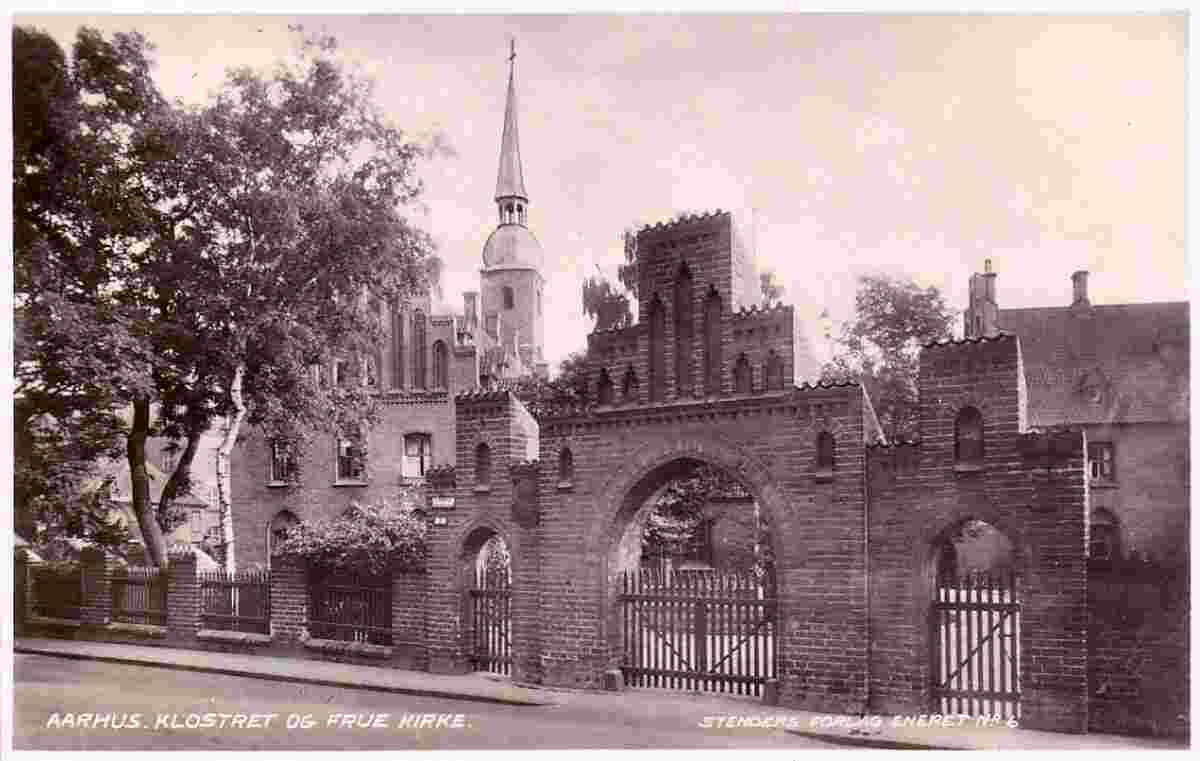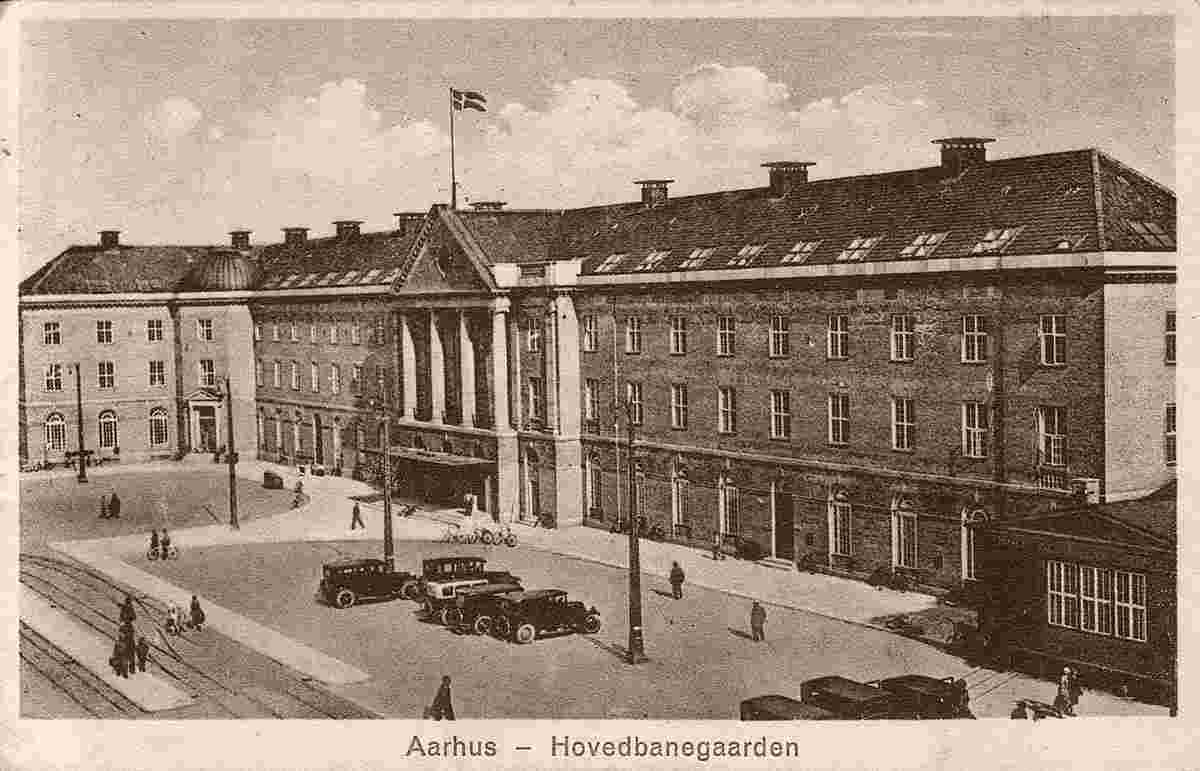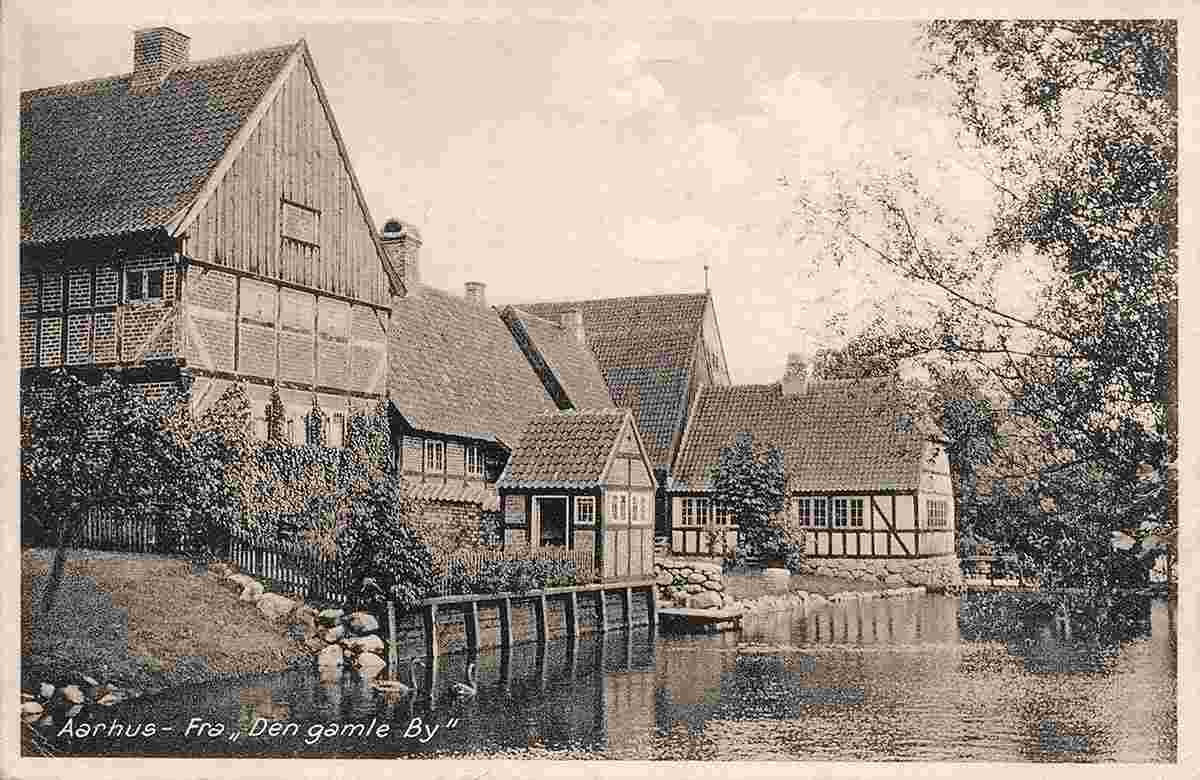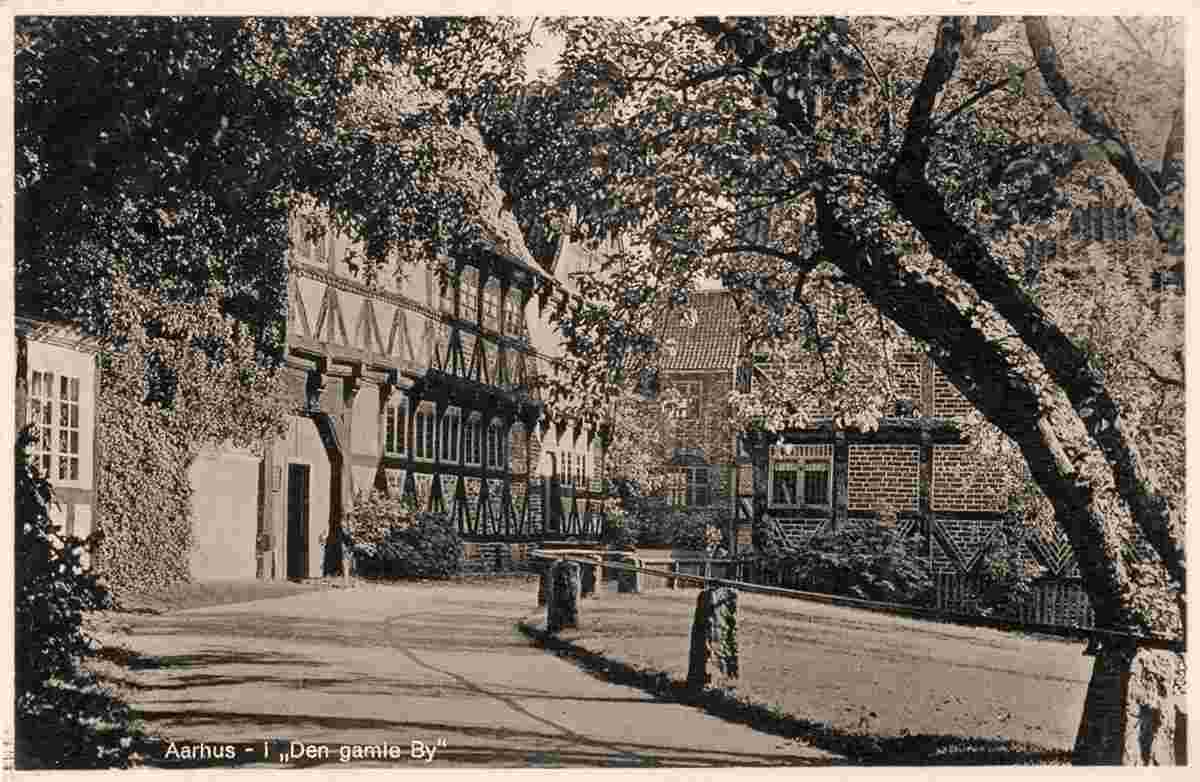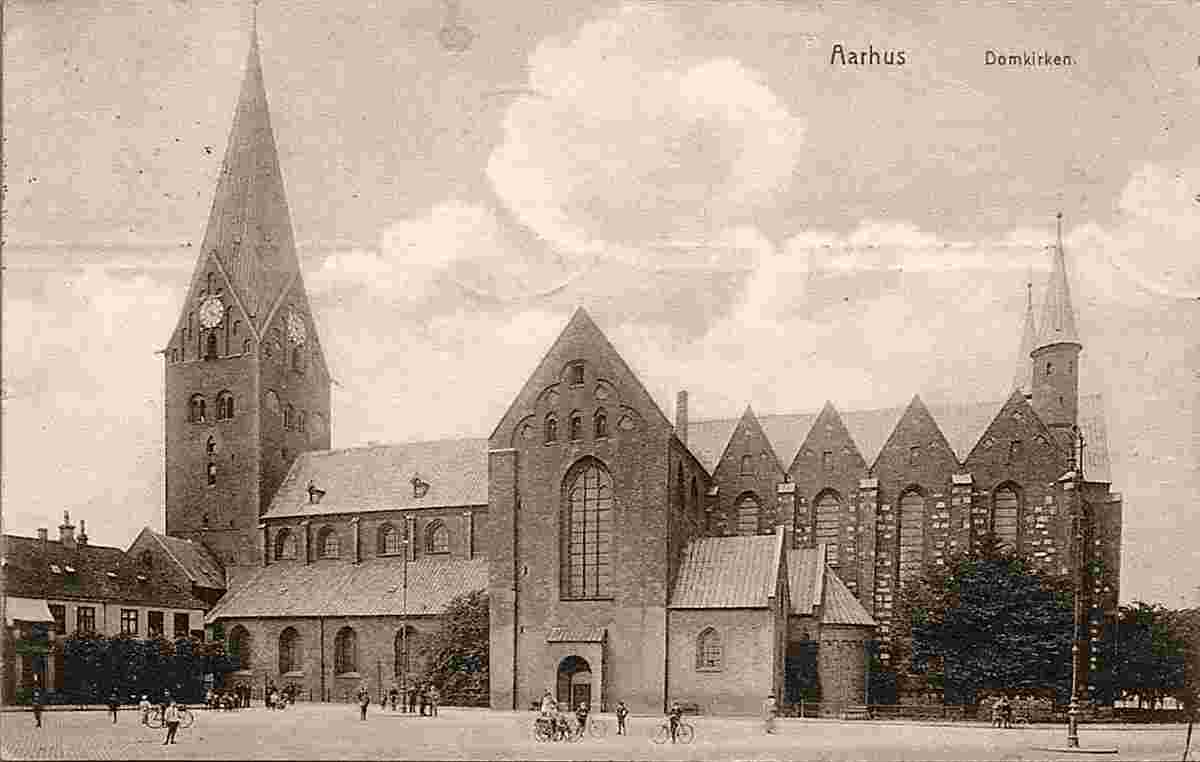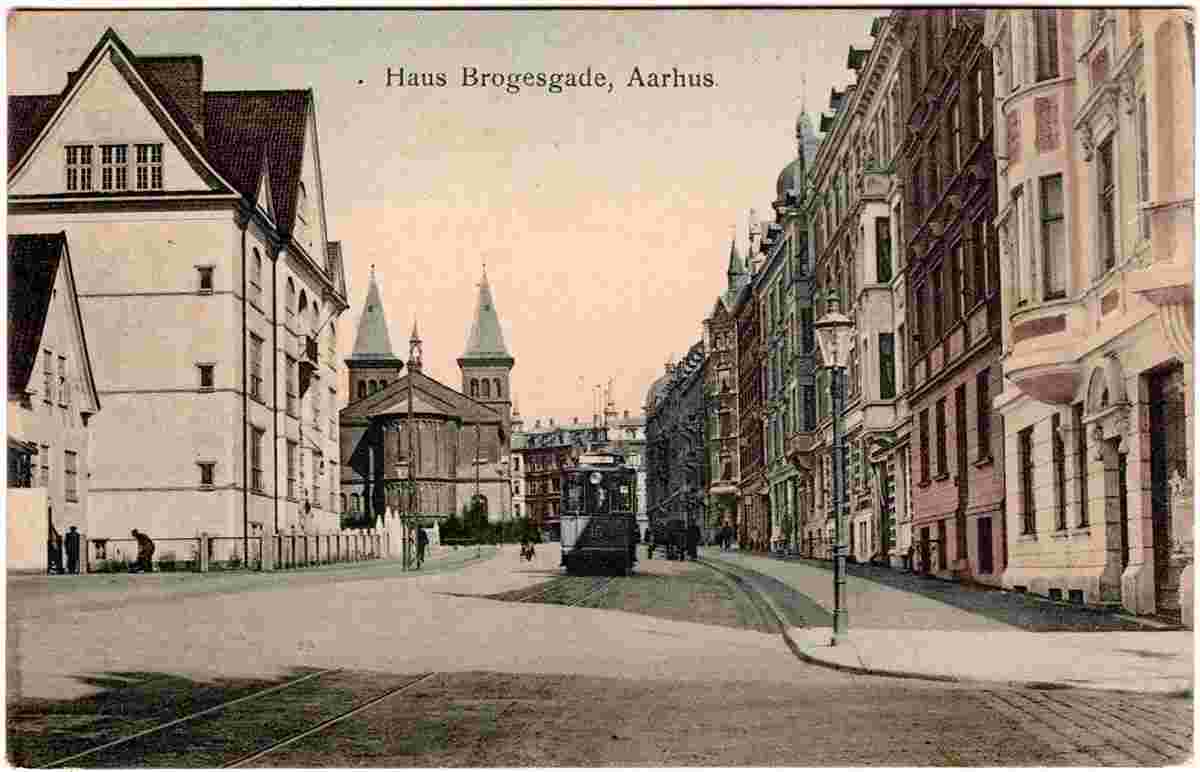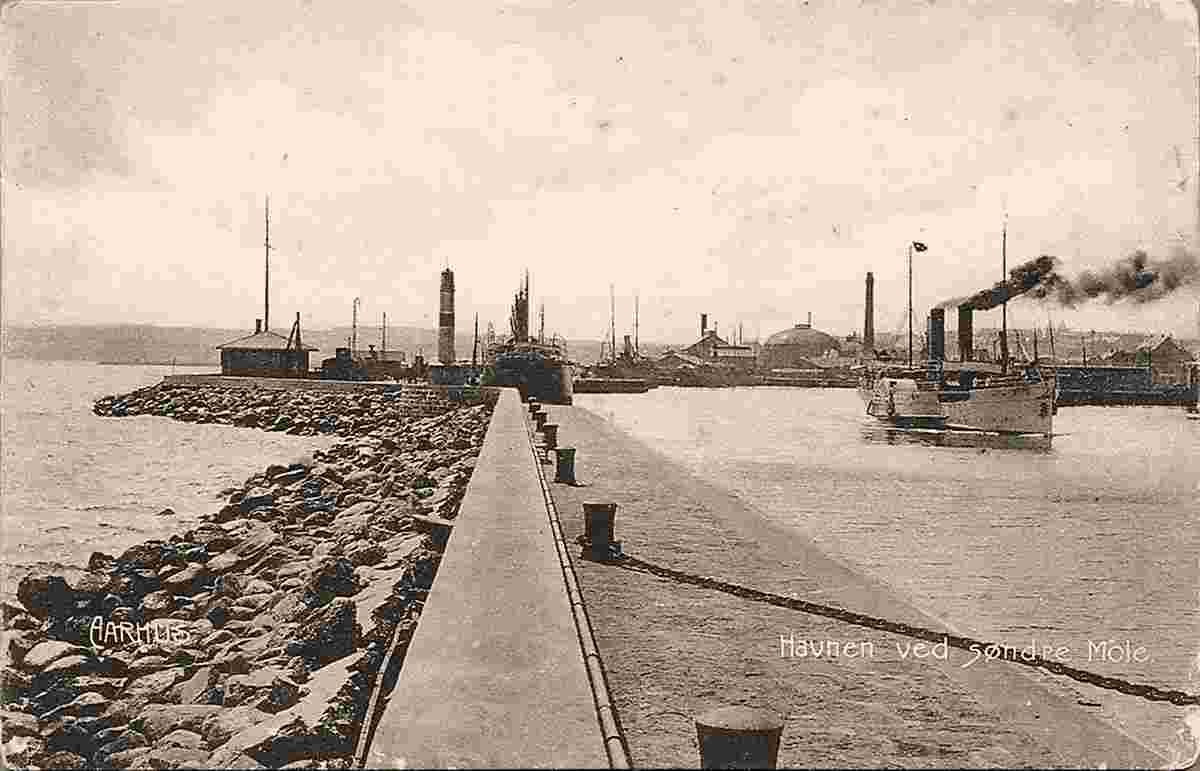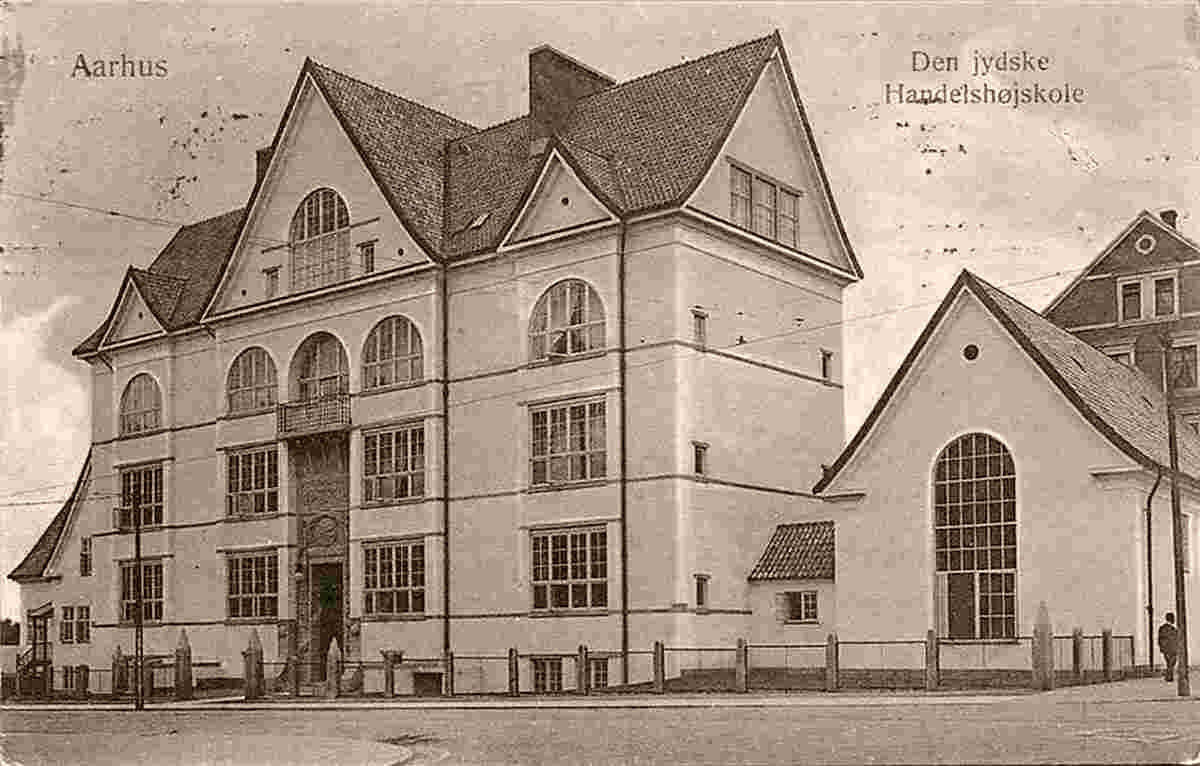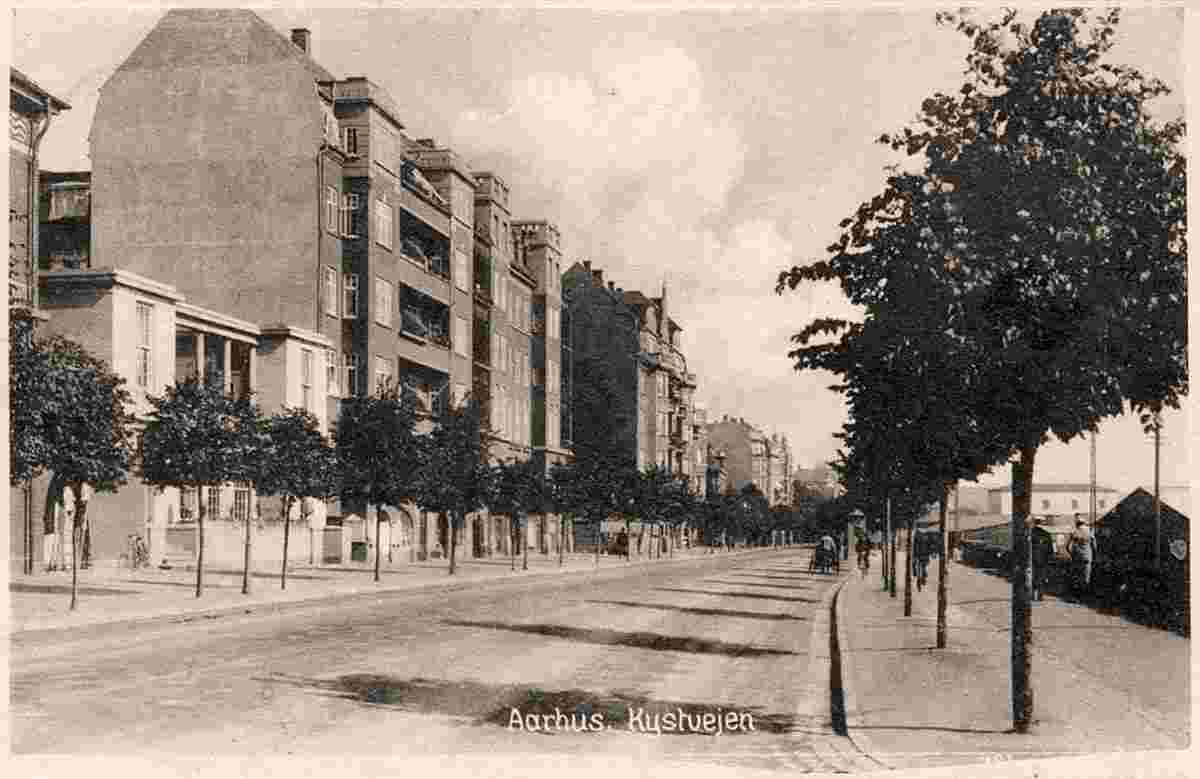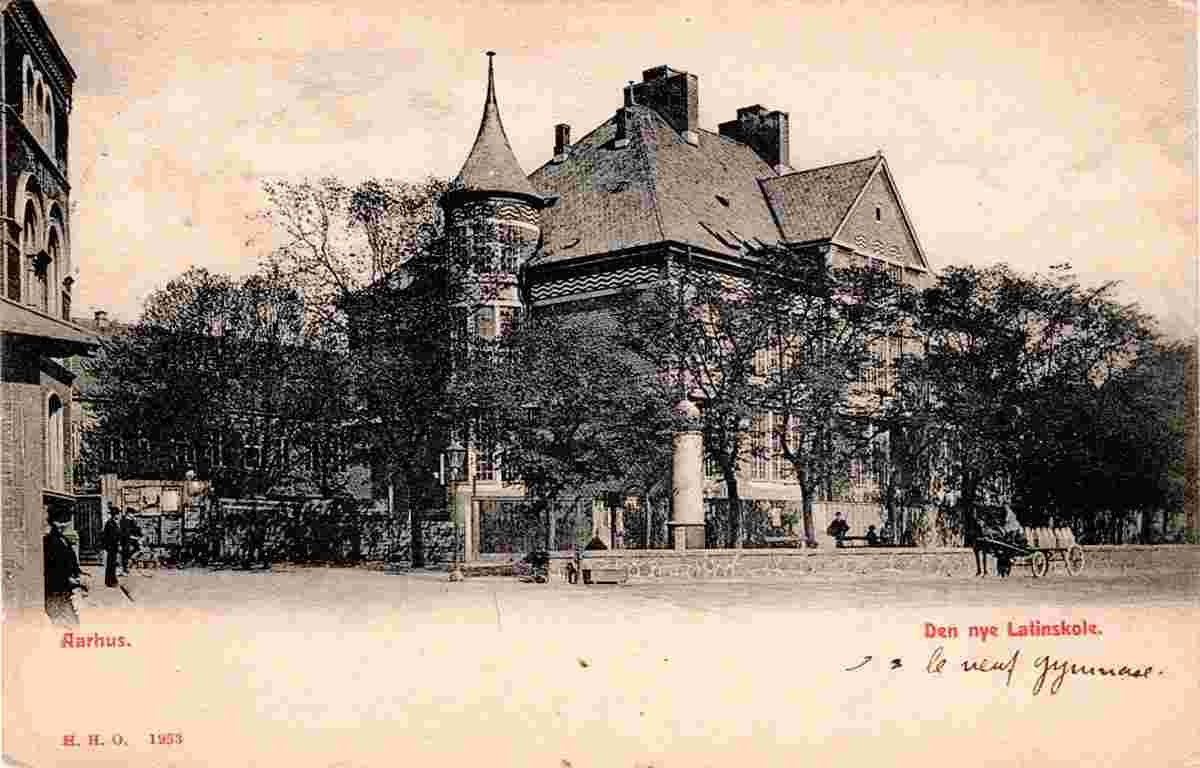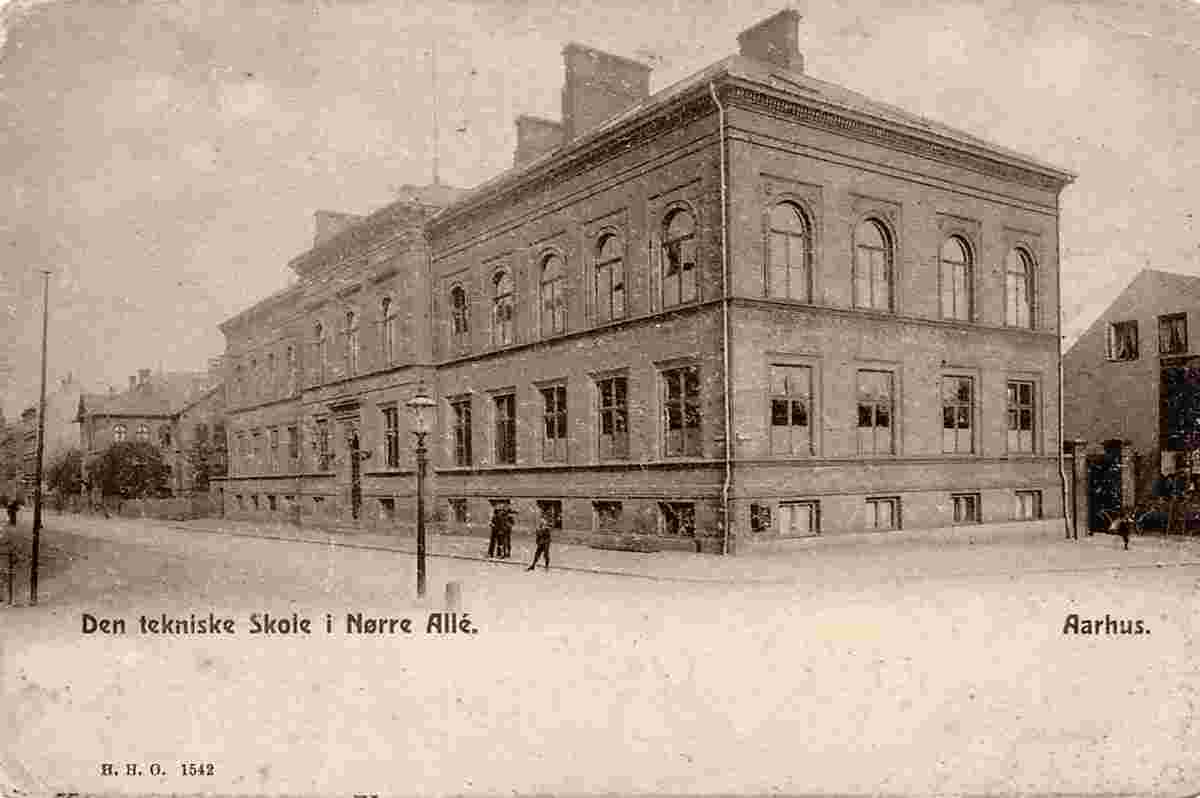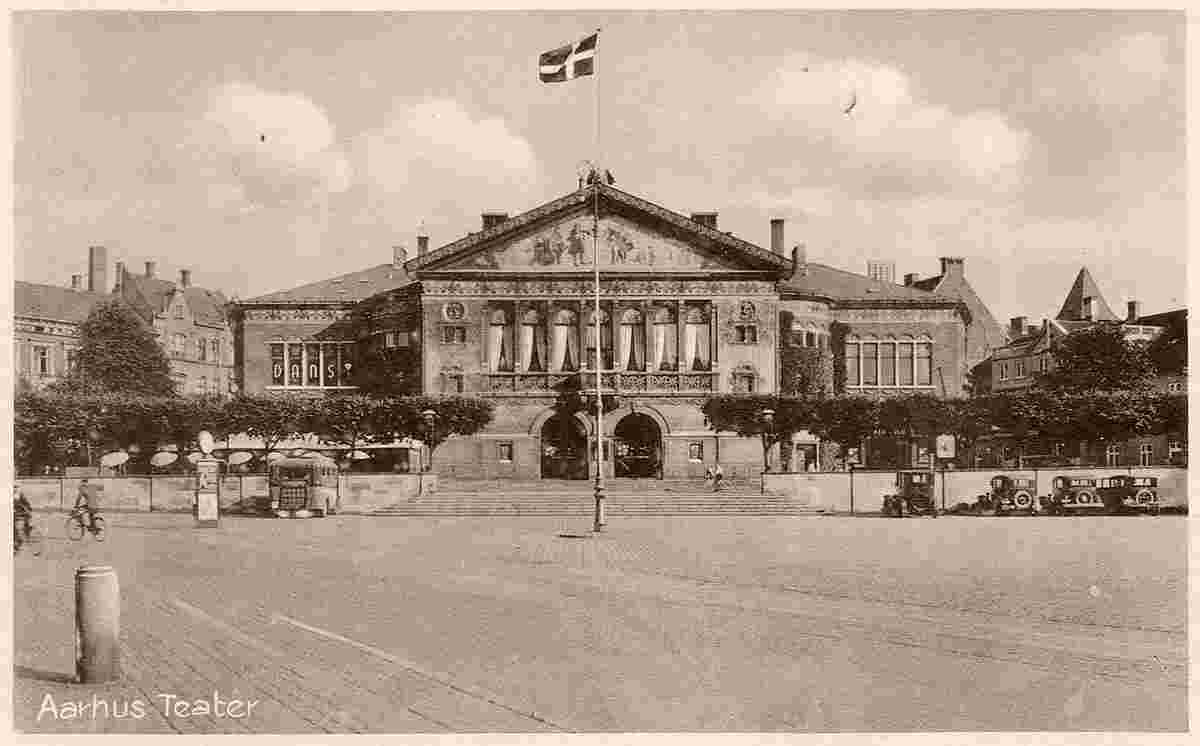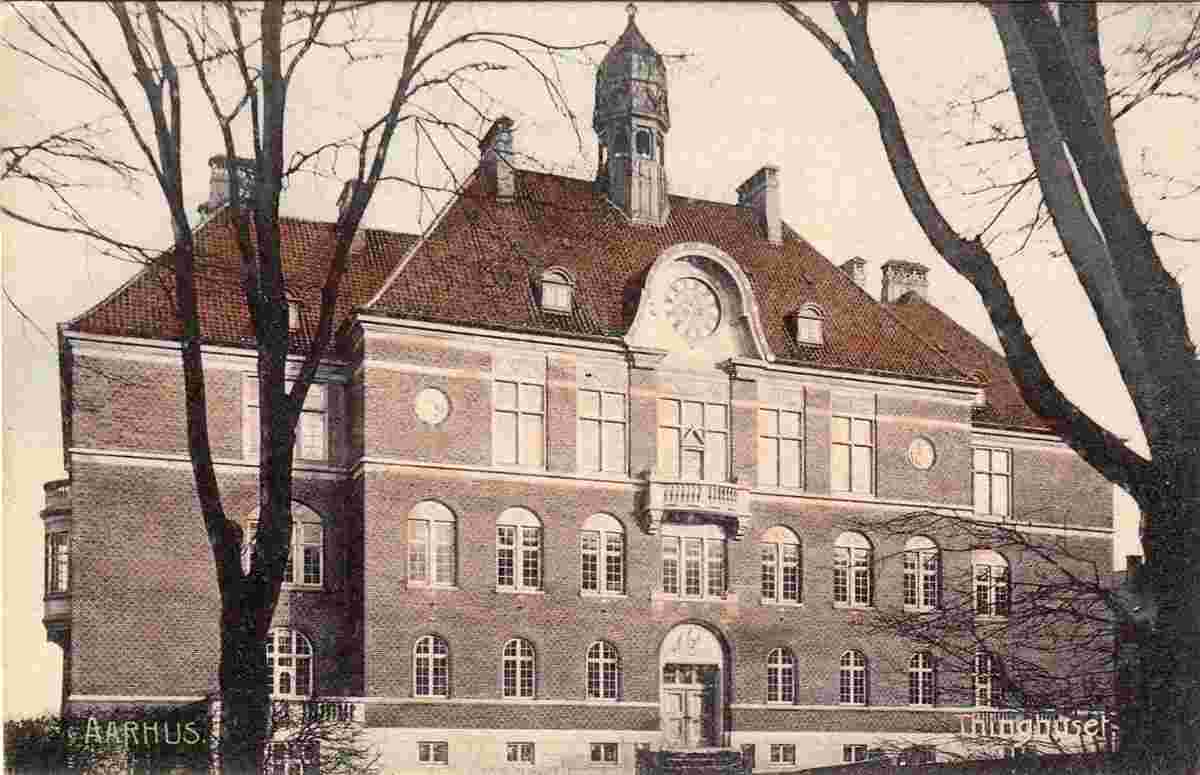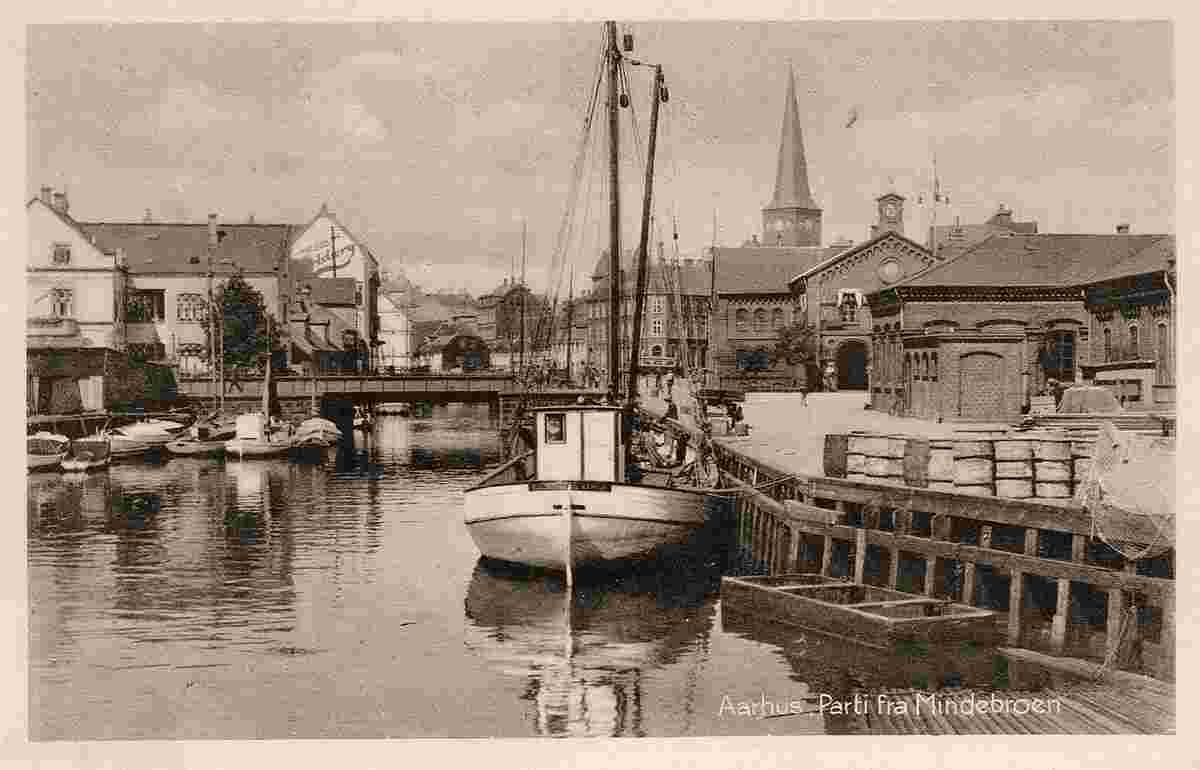Historical and old photos of Aarhus, Central Denmark
HistoryEarly historyFounded in the early Viking Age, Aarhus is one of the oldest cities in Denmark, along with Ribe and Hedeby. Archaeological evidence under the Aros settlement's defences indicate the site was a town as early as the last quarter of the 8th century, considerably earlier than had been generally supposed. Discoveries after a 2003 archaeological dig unearthed half-buried longhouses, firepits, glass pearls and a road dated to the late 700s. Archaeologists have conducted several excavations in the inner city since the 1960s revealing wells, streets, homes and workshops. In the buildings and adjoining archaeological layers, everyday utensils like combs, jewellery and basic multi-purpose tools from approximately the year 900 have been found. The centre of Aarhus was once a pagan burial site until Aarhus's first church, Holy Trinity Church, a timber structure, was built upon it during the reign of Frode, King of Jutland, around 900. In the 900s an earth rampart for the defence of the early city was constructed, encircling the settlement, much like the defence structures found at Viking ring fortresses elsewhere. The rampart was later reinforced by Harald Bluetooth, and together with the town's geographical placement, this suggests that Aros was an important trade and military centre. There are strong indications of a former royal residence from the Viking Age in Viby, a few kilometres south of the Aarhus city centre. The bishopric of Aarhus dates back to at least 948 when Adam of Bremen reported the bishop Reginbrand attended the synod of Ingelheim in Germany. The bishopric and the town's geographical location propelled prosperous growth and development of the early medieval town. The finding of six runestones in and around Aarhus indicates the city had some significance around the year 1000, as only wealthy nobles traditionally used them. The era was turbulent and violent with several naval attacks on the city, such as Harald Hardrada's assault around 1050, when the Holy Trinity Church was burned to the ground. Middle AgesThe growing influence of the Church during the Middle Ages gradually turned Aarhus, with its bishopric, into a prosperous religious centre. Many public and religious buildings were built in and around the city; notably Aarhus Cathedral was initiated in the late 12th century by the influential bishop Peder Vognsen. In 1441, Christopher III issued the oldest known charter granting market town status although similar privileges may have existed as far back as the 12th century. The charter is the first official recognition of the town as a regional power and is by some considered Aarhus's birth certificate. The official and religious status spurred growth so in 1477 the defensive earthen ramparts, ringing the town since the Viking age, were abandoned to accommodate expansion. Parts of the ramparts are still in existence today and can be experienced as steep slopes at the riverside and they have also survived in some place names of the inner city, including the streets of Volden (The Rampart) and Graven (The Moat). Aarhus grew to become one of the largest cities in the country by the early 16th century. In 1657, octroi was imposed in larger Danish cities which changed the layout and face of Aarhus over the following decades. Wooden city walls were erected to prevent smuggling, with gates and toll booths on the major thoroughfares, Mejlgade and Studsgade. The city gates funnelled most traffic through a few streets where merchant quarters were built. In the 17th century, Aarhus entered a period of recession as it suffered blockades and bombardments during the Swedish wars and trade was dampened by the preferential treatment of the capital by the state. It was not until the middle of the 18th century growth returned in large part due to trade with the large agricultural catchment areas around the city; particularly grain proved to be a remunerative export. The first factories were established at this time as the industrial revolution reached the country and in 1810 the harbour was expanded to accommodate growing trade. IndustrialisationFollowing the Napoleonic wars, Denmark lost Norway and was excluded from international trade for some years which caused a recession for Aarhus's trade-based economy that lasted until the 1830s. The economy turned around as the industrial revolution reached the city and factories with steam-driven machinery became more productive. In 1838, the electoral laws were reformed leading to elections for the 15 seats on the city council. The rules were initially very strict allowing only the wealthiest citizens to run. In the 1844 elections only 174 citizens qualified out of a total population of more than 7,000. The first city council, mainly composed of wealthy merchants and industrialists, quickly looked to improve the harbour, situated along the Aarhus River. Larger ships and growing freight volumes made a river harbour increasingly impractical. In 1840, the harbour was moved to the coast, north of the river where it became the largest industrial harbour outside Copenhagen over the following 15 years. From the outset, the new harbour was controlled by the city council, as it is to this day. During the First Schleswig War Aarhus was occupied by German troops from 21 June to 24 July 1849. The city was spared any fighting, but in Vejlby north of the city a cavalry skirmish known as Rytterfægtningen took place which stopped the German advance through Jutland. The war and occupation left a notable impact on the city as many streets, particularly in Frederiksbjerg, are named after Danish officers of the time. Fifteen years later, in 1864, the city was occupied again, this time for seven months, during the Second Schleswig War. In spite of wars and occupation the city continued to develop. In 1851, octroi was abolished and the city walls were removed to provide easier access for trade. Regular steamship links with Copenhagen had begun in 1830 and in 1862 Jutland's first railway was established between Aarhus and Randers. In the second half of the 19th century industrialisation came into full effect and a number of new industries emerged around production and refinement of agricultural products, especially oil and butter. Many companies from this time would come to leave permanent iconic marks on Aarhus. The Ceres Brewery was established in 1856 and served as Aarhus's local brewery for more than 150 years, gradually expanding into an industrial district known as Ceres-grunden (lit.: the Ceres-grounds). In 1896 local farmers and businessmen created Korn- og Foderstof Kompagniet (KFK), focused on grain and feedstuffs. KFK established departments all over the country, while its headquarters remained in Aarhus where its large grain silos still stand today. Otto Mønsted created the Danish Preserved Butter Company in 1874, focusing on butter export to England, China and Africa and later founded the Aarhus Butterine Company in 1883, the first Danish margarine factory. The industry became an important employer, with factory employees increasing from 100 in 1896 to 1,000 in 1931, effectively transforming the city from a regional trade hub into an industrial centre. Other new factories of note included the dockyard Aarhus Flydedok, the oil mill Århus Oliefabrik and the ironworks Frichs. Aarhus became the largest provincial city in the country by the turn of the century and the city marketed itself as the "Capital of Jutland". The population increased from 15,000 in 1870 to 52,000 in 1901 and, in response, the city annexed large land areas to develop new residential quarters such as Trøjborg, Frederiksbjerg and Marselisborg. Many of its cultural institutions were also established at this time such as Aarhus Theatre (1900), the original State Library (1902), Aarhus University (1928) and several hospitals. Second World WarOn 9 April 1940, Germany invaded Denmark, occupying Aarhus the following day and 5 years hence. The occupation was a destructive period with major disasters, loss of life and economic depression. The Port of Aarhus became a hub for supplies to the Baltics and Norway while the surrounding rail network supplied the Atlantic Wall in west Jutland and cargo headed for Germany. Combined, these factors resulted in a strong German presence, especially in 1944–45. The first years were peaceful in conjunction with the policies of the Danish Protectorate Government, but following the enactment of the Communist Law in August 1941, the first armed resistance and sabotage commenced, gradually growing in intensity over the years with repression and terror in response. Small, independent resistance groups first appeared in 1941–42 but the first to co-ordinate with the Freedom Council was the Samsing Group, responsible for most operations from early 1943. The Samsing group, along with others in and around Aarhus, was dismantled in June 1944 when Grethe "Thora" Bartram turned her family and acquaintances over to German authorities. In response, requests for assistance was sent to contacts in England and in October 1944 the Royal Air Force bombed the Gestapo headquarters successfully destroying archives and obstructing the ongoing investigation. The 5 Kolonne group was established with assistance from Holger Danske to restore a resistance movement in Aarhus along with the L-groups, tasked with assassinating collaborators. Resistance operations escalated from mid-1944 with most major sabotage operations and assassinations occurring in the period 1944–45. The growing resistance was countered with 19 Schalburgtage terror operations by the Peter group from August 1944, including large-scale fire bombings and murders. The increasingly destructive occupation was compounded when an ammunition barge exploded in 1944, destroying much of the harbour and damaging the inner city. On 5 May 1945 German forces in Denmark surrendered but during the transitional period fighting broke out in Aarhus between the resistance and German soldiers resulting in 22 dead. Order was restored by the end of the day and on 8 May the British Royal Dragoons entered the city. Post-World War II yearsIn the 1980s the city entered a period of rapid growth and the service sector overtook trade, industry and crafts as the leading sector of employment for the first time. Workers gradually began commuting to the city from most of east and central Jutland as the region became more interconnected. The student population tripled between 1965 and 1977 turning the city into a Danish centre of research and education. The growing and comparably young population initiated a period of creativity and optimism; Gaffa and the KaosPilot school were founded in 1983 and 1991 respectively, and Aarhus was at the centre of a renaissance in Danish rock and pop music launching bands and musicians such as TV2, Gnags, Thomas Helmig, Bamses Venner, Anne Dorte Michelsen, Mek Pek and Shit & Chanel. The 2000sSince the turn of the millennium, Aarhus has seen an unprecedented building boom with many new institutions, infrastructure projects, city districts and recreational areas. Several of the construction projects are among the largest in Europe, such as the New University Hospital (DNU) and the harbourfront redevelopment. Both the skyline and land use of the inner city is changing as former industrial sites are being redeveloped into new city districts and neighbourhoods. Starting in 2008, the former docklands known as De Bynære Havnearealer (The Peri-urban Harbour-areas), and closest to the city seaside, are being converted to new mixed use districts. It is among the largest harbourfront projects in Europe. The northern part dubbed Aarhus Ø (Aarhus Docklands) is almost finished as of 2018, while the southern district dubbed Sydhavnskvarteret (The South-harbour neighbourhood) is only starting to be developed. The adjacent site of Frederiks Plads at the former DSB repair facilities have been under construction since 2014 as a new business and residential quarter. The main bus terminal close by is planned to be moved to the central railway station and the site will be redeveloped to a new residential neighbourhood. Elsewhere in the inner city, the site of the former Ceres breweries was redeveloped in 2012-2019 as a new mixed use neighbourhood known as CeresByen. Construction of Aarhus Letbane, the first light rail system in the country, commenced in 2013, and the first increment was finished in December 2017. Since then, the lightrail service has been expanded with two intercity sections to the towns of Odder and Grenå, respectively, and also includes a northward leg to the suburb of Lisbjerg. The light rail system is planned to tie many other suburbs closer to central Aarhus in the future, with the next phase including local lines to Brabrand in the east and Hinnerup to the north. Accelerating growth since the early 2000s, brought the inner urban area to roughly 260,000 inhabitants by 2014. The rapid growth is expected to continue until at least 2030 when Aarhus municipality has set an ambitious target for 375,000 inhabitants. Origin: en.wikipedia.org | |||||||||||||||||||||
 |
Old historical photos and images of Aarhus, Denmark
Gamle historiske fotos og billeder af Aarhus, Danmark |
| Main page • Countries of Europa • Cities of Denmark |
| Robinson Rd, CB 13862 Nassau, NP, The Bahamas |
